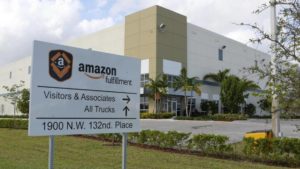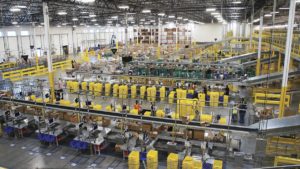Close to Home: “Click” Theory and Real Estate
Mon Jul 29, 2019 by Oppenheim Law on Florida Real Estate & Real Estate
Nearly half a year has gone by since Amazon’s new headquarters search was making headlines. However, though the e-commerce giant has yet to declare where its new home will be located, it is important to note that Amazon, along with other e-commerce companies, are shaping how we live.
Real Estate Industry and Innovation
Back in June, Amazon officially opened its 855,000-square-foot Opa-locka fulfillment center to the public. Aside from the fact that this warehouse space is roughly the size of 14 football fields and brings Amazon’s industrial footprint in Miami-Dade county to around 1.5 million square feet of space, this opening is indicative of a larger, more important trend: e-commerce dominates our industrial real estate market.

Amazon Opa-locka
This should come as no surprise. In Miami-Dade alone, almost 4.5 million square feet of industrial warehouse space was constructed in 2018, largely spearheaded by e-commerce. Nowadays, more than halfway through 2019, Miami-Dade has already recorded approximately 4 million square feet of industrial of leasing activity.
“Close to Clicks” Theory
Dubbed by pundits the “Close to Clicks” theory, e-commerce distributors have been tasked with seeking out distribution centers that are closer to densely populated areas. This way, these companies can quickly reach much of the local population in order to fulfill next-day and same-day deliveries while still keeping shipping costs relatively low. With e-commerce sales totaling $517.36 billion in 2018, out of which Amazon accounted for nearly half, the “Close to Clicks” theory is rapidly transforming itself into a fixture for the foreseeable future.

Amazon Fulfillment Opa-locka
Regarding our sunny South Florida market, e-commerce companies have been especially invested in exploring “Close to Clicks” sites. Considering that Miami-Dade is composed of 2.7 million residents, making it the seventh most-populated county in America, not to mention that its neighboring Broward County boasts a population of 1.9 million residents, and Miami was also recently rated as the sixth-fastest-growing population nationwide, the demand for well-managed, well-situated industrial warehouse space will continue to be important.
Geographic Implications
Interestingly enough, one major caveat of this industrial real estate search in South Florida is our natural geographic setting. With the Atlantic Ocean to the east and the Everglades to the west, industrial developers have had to get creative to find the ideal location for the coveted, last-mile center. Whether by refilling lakes or building atop construction debris landfills, our unique South Florida typography may become forever altered, with the creation of more industrial warehouse space needed to meet our e-commerce demands.
From The Trenches,
Roy Oppenheim


Leave a Reply